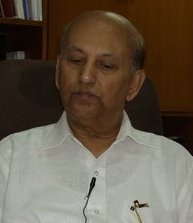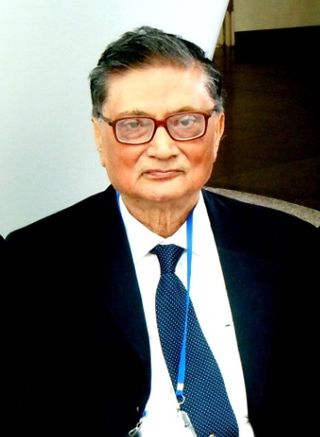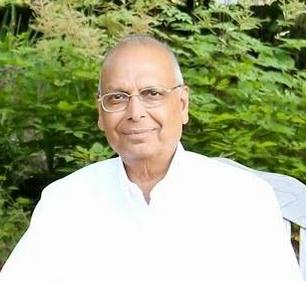Mahendra Singh Sodha | |
|---|---|
| Born | 8 Feb 1932 India |
| Nationality | Indian |
| Known for | Plasma Physics Theory |
| Awards | Shanti Swarup Bhatnagar Award Padma Shri Hari Om Prerit S. S. Bhatnagar Award Pioneer in Renewable Energy Award Dr. K. S. Rao Memorial National Award |
| Scientific career | |
| Fields | Plasma Physics, Laser Physics |
Mahendra Singh Sodha, popularly known as M. S. Sodha, is an Indian physicist specialising in Plasma, Optics and Energy and a former vice chancellor of Lucknow University, Devi Ahilya University and Barkatullah University. [1] [2] A 1974 winner of the highest Indian science award, Shanti Swarup Bhatnagar Prize, Sodha was honoured by the Government of India again in 2003 with Padma Shri, the fourth highest Indian civilian award. [3]
M. S. Sodha, born on 8 February 1932, [4] secured his master's degree (MSc) in physics in 1951 from Allahabad University and started his career as a junior scientist by joining the Defence Science Laboratory, New Delhi, present day Laser Science and Technology Centre, in 1953. [1] During the same period, he pursued his doctoral studies and obtained a doctoral degree (DPhil) [4] in 1955 from the same university. [1] [5] He continued at DSL till 1956 and moved to the University of British Columbia, Canada as a post doctoral fellow to stay there till 1958, [1] when he shifted to USA, to work as senior scientist at the Armour Research Foundation, Chicago, till 1961 and then as a senior scientist and chief of physics at the Republic Aviation Company, New York. [1] [5] In 1964, he returned to India to and joined the Indian Institute of Technology, Delhi as the professor where he rose in ranks to become the dean, head of the department and finally, a deputy director of the institution till his retirement in 1992. [1] [5] During this period, he also served as the vice chancellor of Devi Ahilya University from 1988 to 1992. [1] [4] [5] In 1992, he was appointed as the vice chancellor of Lucknow University for a three-year term from 1992 to 1995 and, later, at the Barkatullah University from 1998 to 2000. [1] [4] [5] He has also served as a visiting professor at Drexel University and is a visiting professor and Ramanna Fellow of Lucknow University. [1] [5]
Sodha has done extensive research in the physical science disciplines of plasma and energy. [2] He is credited with pioneering researches on colloidal plasmas, optics and Akhamanov's formulation and he presented papers on quantitative theory of image formation in layered media. [1] His book, Microwave Propagation in Ferrimagnetics [6] is reported to be the first book on the subject. He has also published 13 books [5] including Solar Crop Drying, [7] Solar Distillation [8] and Solar Passive Building: Science and Design [9] and had edited a book, Sodha Reviews of Renewable Energy Resources. [10] He has also published over 500 research papers [5] [11] [12] in peer reviewed journals [13] [14] and mentored several students for their doctoral studies. [1] [5]
Sodha contributed to the establishment of divisions such as the Centre of Energy Studies and Research, Opto-Electronics Group and Plasma Physics Group at the Indian Institute of Technology, Delhi. [1] During his tenure as the vice chancellor of Lucknow University and Devi Ahilya Vishwavidyalaya, he was instrumental in introducing self-financing as an option for academic studies [1] and reportedly played a part in the establishment of Faculty of Engineering Science at Devi Ahalya Vishavidyalaya. [5] He served as the president of Plasma Science Society of India and Optical Society of India. [1]
Sodha is an elected fellow of the Indian National Science Academy [1] and the National Academy of Sciences, India. [4] [5] He achieved the highest Indian science award, Shanti Swarup Bhatnagar Prize for Physics in 1974. [1] [2] [5] Four years later, he received Hari Om Prerit S. S. Bhatnagar Award [5] followed by the Pioneer in Renewable Energy Award from the World Renewable Energy Network and UNESCO in 2002. [1] The Government of India honoured him in 2003 with the civilian award of Padma Shri. [3] He received Dr. K. S. Rao Memorial National Award in 2004. [1] Sodha was felicitated by the Indian Institute of Technology, Delhi on 21 March 2011 at the Honour the Mentor program. [15]
Predhiman Krishan Kaw was an Indian plasma physicist. He had been the founding director of the Institute for Plasma Research and served the institute as the director from 1986 to 2012.

Udupi Ramachandra Rao was an Indian space scientist and former chairman of the Indian Space Research Organisation. He was also the Chairman of the Governing Council of the Physical Research Laboratory at Ahmedabad and Nehru Planetarium at Bengaluru and chancellor of the Indian Institute for Space Science and Technology (IIST) at Thiruvananthapuram. He is known as "The Satellite Man of India". He pioneered India's first satellite launch Aryabhata in 1975.

Devi Ahilya Vishwavidyalaya, formerly University of Indore, is a state university located in Indore, India. It was named after Ahilya Bai Holkar, the 18th century Queen and ruler of Indore, daughter in law of Malhar Rao Holkar who was the founder of Holkar Dynasty.

Anil K. Rajvanshi is an academic from India, and is the current director of the Nimbkar Agricultural Research Institute (NARI).
Akhlesh Lakhtakia is Evan Pugh University Professor and Charles Godfrey Binder Professor of engineering science and mechanics at the Pennsylvania State University. His research focuses on electromagnetic fields in complex materials, such as sculptured thin films, chiral materials, bianisotropy and industrially scalable bioreplication, an emerging form of engineered biomimicry applied to harvesting of solar energy and pest eradication. His technique for visualization of latent fingerprints was covered in the NOVA documentary series "Forensics on Trial".

Ajoy Kumar Ghatak is an Indian physicist and author of physics textbooks.
The School of Chemical Science or 'SOCHEM' is a Chemistry and Technical education school in Indore, India. SOCHEM is a University Teaching Department of Devi Ahilya University. The institute is situated in the Takshila Campus of Devi Ahilya University. It was founded in 1972.
Ajit Ram Verma (1921-2009) was an Indian physicist. For his work in crystallography, he was awarded the Shanti Swarup Bhatnagar Prize in 1964. He was director of the National Physical Laboratory (NPL) for almost seventeen years (1965-1982). In 1982, the Padma Bhushan, India's third highest civilian award, was conferred on him by the President of India.
Shashikumar Madhusudan Chitre FNA, FASc, FNASc, FRAS was an Indian mathematician and astrophysicist, known for his research in Astronomy and Astrophysics. The Government of India honored him, in 2012, with Padma Bhushan, the third highest civilian award, for his services to the sciences.
Suhas Pandurang Sukhatme is an Indian scientist, teacher, author and a former Chairman of the Atomic Energy Regulatory Board of the Government of India, known for his expertise in heat transfer and energy technologies. He was honoured by the Government of India, in 2001, with the fourth highest Indian civilian award of Padma Shri.

Asok Kumar Barua was an Indian condensed matter physicist and the honorary Emeritus Professor of Indian Institute of Engineering Science and Technology, Shibpur, who focused on research in optics and optoelectronics. He was honoured by the Government of India in 2003 with Padma Shri, the fourth highest Indian civilian award.
Bindhyavasini Devi was an Indian folk musician. She was popularly recognised as Bihar Kokila. She was the founder of Vindhya Kala Mandir, a Patna based music academy promoting folk music, Vindhya Kala Mandir. The academy is associated with Bhatkhande University, Lucknow for 55 years now which is now run by her daughter-in-law Shobha Sinha, son Sudhir Kumar Sinha. She was born in Muzzafarpur in the Indian state of Bihar and specialised in Maithili, Bhojpuri and Magahi folk music. She also sang a popular song, Chhote Dulha Ke, in a movie, Vivah Geet and many of her songs have been released in CD format.

Valangiman Subramanian Ramamurthy is an Indian nuclear physicist with a broad range of contributions from basic research to Science and Engineering administration.Prof.Ramamurthy started his career in Bhabha Atomic Research Centre, Mumbai in the year 1963. He made important research contributions in the area of nuclear fission, medium energy heavy ion reactions, statistical and thermodynamic properties of nuclei and low energy accelerator applications. During the period 1995-2006, Prof.Ramamurthy was fully involved in Science administration as Secretary to Government of India, Department of Science and Technology, (DST), New Delhi.Other important assignments held by him include Director, Institute of Physics, Bhubaneswar, (1989-1995), DAE Homi Bhabha Chair in the Inter-University Accelerator Centre, New Delhi (2006-2010), and Director of the National Institute of Advanced Studies, Bengaluru (2009-2014). He is a former chairman of the Recruitment and Assessment Board of the Council of Scientific and Industrial Research and has served as a member of the design team of the first Indian nuclear experiment in Pokhran on 18 May 1974. The Government of India awarded him the third highest Indian civilian honour of Padma Bhushan in 2005.
Badanaval Venkatasubba Sreekantan was an Indian high-energy astrophysicist and a former associate of Homi J. Bhabha at the Tata Institute of Fundamental Research (TIFR). He was also a Dr. S. Radhakrishnan Visiting Professor at the National Institute of Advanced Studies, Bangalore.
Vishnu Ganesh Bhide (1925–2006) was an Indian physicist and educationist, known for his pioneering work on Mossbauer spectroscopy and his contributions to science education in India. He was the scientific advisor to the Government of India during 1973-75 and a member of the International Commission on the Applications of Mossbauer Effect. The Government of India awarded him the fourth highest civilian honour of the Padma Shri in 1992.
Onkar Nath Srivastava was an Indian material physicist, an Emeritus professor of Banaras Hindu University and the vice president for India and South Asia of the International Association for Hydrogen Energy, who was known for his contributions to the disciplines of nanotechnology and hydrogen energy. He was the author of two books and over 440 scientific papers and a recipient of several honors including Shanti Swarup Bhatnagar Prize, the highest Indian award in the science and technology categories. The Government of India awarded him the fourth highest civilian honour of the Padma Shri, in 2016, for his contributions to science and engineering.

Kasturi Lal Chopra was an Indian materials physicist and a former director of the Indian Institute of Technology, Kharagpur. He was the founder of the Thin Film Laboratory at Indian Institute of Technology, Delhi and the Microscience Laboratory at IIT, Kharagpur and held several US and Indian patents for his research findings. Author of a number of books on thin film technology, he was a recipient of Shanti Swarup Bhatnagar Prize, the highest Indian award in the science and technology categories. The Government of India awarded him the fourth highest civilian honour of the Padma Shri, in 2008, for his contributions to science and engineering.

Anurag Sharma is an Indian physicist and a professor at the department of physics of the Indian Institute of Technology Delhi. He is known for his pioneering researches on optoelectronics and optical communications and is an elected fellow of all the three major Indian science academies viz. Indian Academy of Sciences, Indian National Science Academy and National Academy of Sciences, India as well as Indian National Academy of Engineering. The Council of Scientific and Industrial Research, the apex agency of the Government of India for scientific research, awarded him the Shanti Swarup Bhatnagar Prize for Science and Technology, one of the highest Indian science awards for his contributions to Engineering Sciences in 1998.
Arti Agrawal is a scientist and engineer known for her work on computational photonics as well as diversity, equity, and inclusion in STEM; she has been recognized in both of these areas by a number of awards. Her research is focused on numerical modeling and simulation of photonic devices and optical components. Agrawal is currently serving as Associate Professor and the Director of Women in Engineering and Information Technology at the University of Technology Sydney and Associate Vice President of Diversity for the IEEE Photonics Society.

N K Bansal was a former Head and Senior Professor of Centre for Energy Studies at the Indian Institute of Technology (IIT) Delhi, and a Vice-Chancellor of Shri Mata Vaishno Devi University (SMVDU). Bansal was the recipient of the fellowship of the German Academic Exchange Service as well as holder of the Alexander von Humboldt Fellowship from Germany, and his work on climatic zones and passive building design is used extensively by researchers and practitioners.
{{cite book}}: |author= has generic name (help){{cite book}}: |author= has generic name (help)